Growing up as a boy in Kentucky, I often entertained fantasies of being a cowboy. Now as an adult, I get to live out little bits of those fantasies every time I travel to the mountain Northwest.
Whether it’s on horseback, on a railroad or in the midst of a re-created cow town, opportunities for reliving the glory days of the Old West are abundant. From Kansas to Idaho, the traditions of the West are still alive and well, and visitors can experience them in a wide variety of ways.
So next time your group follows the Oregon Trail into the great Northwest, consider making time for some of these authentic experiences.
Old Cowtown Museum
Wichita, Kan.
As America expanded westward in the 19th century, pioneer encampments slowly grew into small towns and eventually major cities. The Old Cowtown Museum in Wichita, Kan., gives visitors a look at what life in the area would have been like in these early stages of Wichita’s development.
“Old Cowtown M
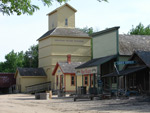 |
| Re-created streets at the Old Cowtown Museum Courtesy Old Cowtown Museum |
useum depicts the city from 1865 to 1880,” said the museum’s executive director, David Flask. “We have roughly 45 historic buildings on 23 acres. We have an interpretive staff that operates the buildings the way they would have been then.”
Visitors start in the Old Town area, which has three of the first log cabins built in Wichita. From there, they can go to the operating 1800s farm, with a farmhouse, outbuildings and a number of farm animals. Another section of the property has an interpretation of a more developed town with dirt streets, boardwalks and numerous home and office buildings.
The interpretive staff adds a number of touches to make the experience more authentic.
“We focus on the cowboy era, so we do things like gunfights periodically,” Flask said. “Every day we have a covered wagon or old stagecoach that people can hop on and ride out to the farm or around the village.”
Durango and Silverton Narrow Gauge Railroad
Durango, Colo.
In the mountains of Colorado, groups can take a ride with a railway that has been in operation since the days of the Wild West. The Durango and Silverton Narrow Gauge Railroad connects two former mining towns set amidst the beautiful Rocky Mountains.
“The train started going from Durango to Silverton in 1882,” said Andrea Seid, marketing manager for the railroad. “The line was originally created to haul silver ore between the two towns. But within a short time, people started realizing that there were amazing views along the way, so it became a tourist railroad, too.”
Today, the train operates along the same 45-mile stretch of track, climbing from an elevation of 6,500 feet in Durango to 9,300 feet in Silverton. Along the way, the line passes through scenic spots such as the Animas River Canyon and Rockwood Cut, where you can almost reach out and touch the rock on either side of the train. During the two-hour turnaround in Silverton, guests enjoy the historic ambiance of an old Western town.
“It’s an absolutely beautiful town, surrounded by mountains,” Seid said. “Most of the streets are still made of dirt, and there’s still a mine that you can go and tour.”
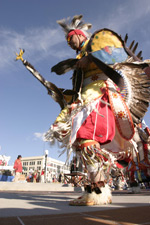 |
| Native American dances are part of the festivities at Cheyenne Frontier Days. Courtesy Cheyenne Area CVB |
Deadwood, S.D.
History remembers Deadwood, S.D., as one of the most famously rough Western settlements on the entire frontier. The town is known for the likes of Wild Bill Hickok, Calamity Jane and other legends of the Old West, and has recently found renewed notoriety as the subject of a controversial HBO television series of the same name.
Although the law eventually caught up with Deadwood, the small city has continued to tiptoe along the edge of vice since its glory days. Gaming is omnipresent in Deadwood, but there’s plenty to see and do outside of the casinos. Several companies offer city tours that take visitors through historic sections of town, pointing out, among other things, the spots where Hickok was killed and buried.
The city also takes advantage of its lore to thrill visitors with re-enactments of scenes from its rough-and-tumble past. The actors involved look the part, sporting long hair, thick beards, dirty clothes and tattoos.
Several of the scenes involve shootouts complete with ear-pounding explosions and gun-smoke effects created with dry Cream of Wheat cereal.
American West Heritage Center
Wellsville, Utah
Native American groups and fur traders made their home in the Wellsville area of Utah in the early 1800s. Today, the American West Heritage Center offers a look at what their lives might have been like.
“We’re a 275-acre living-history facility,” said executive director Steve DeLong. “We offer a small museum exhibit area that tells the heritage of our valley and region. Then you’re able to go outdoors, where you can experience the Native American history of our area, the fur trade history of our valley, our pioneer history and our turn-of-the century agriculture.”
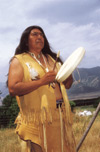 |
| Native American rituals at the American West Heritage Center Courtesy American West Heritage Center |
Historical structures on the property include cabins, old pioneer dugouts and a farm complete with a farmhouse, a summer kitchen, a blacksmith shop and auction barns. The fur traders’ camp and Indian village are composed of period-correct teepees.
Interpreters throughout the site help to illustrate daily life in such surroundings.
“We’re cooking in the farmhouse and demonstrating various techniques on the wood-burning stove,” DeLong said. We have a blacksmith there working, and we’ll have a team of horses running and doing farm work. You can help milk the cows and feed the chickens.”
Special events throughout the year include Pioneer Jubilee, a Celtic festival and a fall harvest festival.
Cheyenne, Wyo.
Western tradition is alive and well in Cheyenne thanks in part to a massive annual event.
“We are known internationally for Cheyenne Frontier Days, which is the world’s largest outdoor r
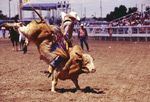 |
| A rodeo at Cheyenne Frontier Days Courtesy Cheyenne Area CVB |
odeo and Western celebration,” said Darren Rudloff, executive director of the Cheyenne Area Convention and Visitors Bureau. “It’s an over-the-top event that is very popular with groups. It has nine days of rodeos and nine nights of top-notch singers and entertainers performing in the arena.”
In addition to attending rodeo competitions and concerts, groups that go to Frontier Days can visit a re-created cowboy town and Indian village on site and see artisans working period handicrafts. The fe
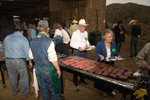 |
| Groups dining at Bit-O-Wyo Ranch Courtesy Cheyenne Area CVB |
stival also offers a “behind the chutes” tour, during which participants can see animals and cowboys being prepared for their big moments in the rodeo ring.
Interested visitors can get a bit of horseback experience at Bit-O-Wyo Ranch.
“You can go for a beautiful horseback ride, and then they have a horse-barn dinner theater,” Rudloff said. “The family are all top-notch musicians, and they do a dinner theater with a steak-and-potato dinner, music into the evening and horses around the barn area.”
www.cheyenne.org










